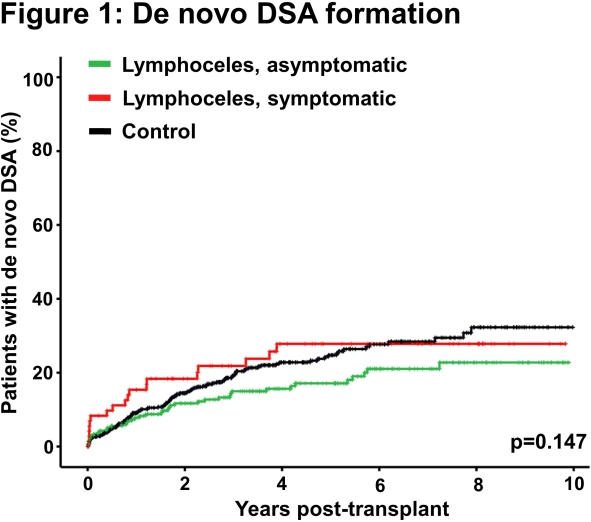The Impact of Lymphocele Formation after Kidney Transplantation on De Novo Donor Specific Antibody Formation
Dept. of Nephrology and Medical Intensive Care, Charité
Universtitätsmedizin Berlin, Berlin, Germany.
Meeting: 2018 American Transplant Congress
Abstract number: C172
Keywords: HLA antibodies, Kidney transplantation, Rejection
Session Information
Session Name: Poster Session C: Kidney Technical
Session Type: Poster Session
Date: Monday, June 4, 2018
Session Time: 6:00pm-7:00pm
 Presentation Time: 6:00pm-7:00pm
Presentation Time: 6:00pm-7:00pm
Location: Hall 4EF
Introduction: Lymphocele formation is a common complication after kidney transplantation and has been linked to rejection episodes. However, long-term outcome data are scarce and the impact of lymphocele formation on the development of de novo donor specific antibodies (dnDSA) has not been investigated so far.
Methods:This retrospective single center study includes 867 adult transplant recipients, who received either cadaveric or living donor kidneys from 2006-2015. All patients received routine graft sonography for identification of lymphoceles. Patients with symptomatic or asymptomatic lymphoceles were evaluated for biopsy proven rejection episodes and dnDSA formation in comparison to the control group.
Results: In our cohort, 307 (35%) patients were identified with lymphocele formation.Of these patients 72 (8%) required intervention due to symptomatic lymphoceles. Lymphocele formation was significantly associated with higher age, longer cold ischemia time, deceased kidney donation, rejection episodes and delayed graft function in the univariate logistic regression model. Multivariate analysis, adjusted for all relevant factors, revealed living donation as protective factor (OR 0.55, p <0.001) and rejection episode as independent risk factor (OR 1.61, p=0.003) for lymphocele formation. Observation of antibody formation over a maximum time span of 10 years post-transplant did not reveal a significant difference between symptomatic and asymptomatic patients compared to the control group by log-rank analysis (figure 1). The adjusted multivariate analysis confirmed that lymphocele formation did not increase the risk for dnDSA development (HR 0.79, p=0.161).
Conclusion: In accordance with findings by other groups, rejection episodes were also associated with lymphocele development in our cohort. However, neither symptomatic or asymptomatic lymphocele formation resulted in increased formation of dnDSA. Although rejection episodes might play a role in lymphocele formation, lymphoceles do not seem to add a significant risk for dnDSA development. 
CITATION INFORMATION: Lehner L., Hohberger A., Halleck F., Schrezenmeier E., Budde K., Staeck O., Khadzhynov D. The Impact of Lymphocele Formation after Kidney Transplantation on De Novo Donor Specific Antibody Formation Am J Transplant. 2017;17 (suppl 3).
To cite this abstract in AMA style:
Lehner L, Hohberger A, Halleck F, Schrezenmeier E, Budde K, Staeck O, Khadzhynov D. The Impact of Lymphocele Formation after Kidney Transplantation on De Novo Donor Specific Antibody Formation [abstract]. https://atcmeetingabstracts.com/abstract/the-impact-of-lymphocele-formation-after-kidney-transplantation-on-de-novo-donor-specific-antibody-formation/. Accessed November 25, 2025.« Back to 2018 American Transplant Congress
